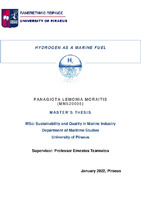| dc.contributor.advisor | Τζαννάτος, Ερνέστος | |
| dc.contributor.advisor | Tzannatos, Ernestos | |
| dc.contributor.author | Μωραΐτη, Παναγιώτα Λεμονιά | |
| dc.contributor.author | Moraiti, Panagiota Lemonia | |
| dc.date.accessioned | 2022-04-04T06:18:57Z | |
| dc.date.available | 2022-04-04T06:18:57Z | |
| dc.date.issued | 2022-01 | |
| dc.identifier.uri | https://dione.lib.unipi.gr/xmlui/handle/unipi/14275 | |
| dc.identifier.uri | http://dx.doi.org/10.26267/unipi_dione/1698 | |
| dc.format.extent | 141 | el |
| dc.language.iso | en | el |
| dc.publisher | Πανεπιστήμιο Πειραιώς | el |
| dc.rights | Αναφορά Δημιουργού-Μη Εμπορική Χρήση-Όχι Παράγωγα Έργα 3.0 Ελλάδα | * |
| dc.rights | Αναφορά Δημιουργού-Μη Εμπορική Χρήση-Όχι Παράγωγα Έργα 3.0 Ελλάδα | * |
| dc.rights.uri | http://creativecommons.org/licenses/by-nc-nd/3.0/gr/ | * |
| dc.title | Hydrogen as a marine fuel | el |
| dc.type | Master Thesis | el |
| dc.contributor.department | Σχολή Ναυτιλίας και Βιομηχανίας. Τμήμα Ναυτιλιακών Σπουδών | el |
| dc.description.abstractEN | Climate change is one of the most significant problems confronting our world, caused mostly by GHG emissions that trap heat in the earth's atmosphere, resulting in global warming. Shipping has a huge impact on global environmental pollution, notably air pollution. Countries are now pursuing aggressive GHG emission reduction measures as a result of the 2015 Paris Agreement. Furthermore, the IMO adopted an initial strategy in 2018 to reduce GHG emissions from international shipping by at least 50% from 2008 levels by 2050, with the objective of completely eliminating them. As a result, shipping's CO2 emissions must be lowered in the next decades. One of the countermeasures for CO2 emissions from ships is the use of hydrogen as an
eco-friendly fuel.
The current study was focused on the development of a portfolio of hydrogen use as a marine fuel. It was found from 2000 until today 84 hydrogen-powered vessels projects. The Netherlands, Norway, and Germany appear to have the most hydrogen powered boats with 19%, 18%, and 14%, respectively. Fuel cells are the preferred hydrogen propulsion method with the most important being the PEMFC. Hydrogen is stored either as compressed gas at 350 bar, or in liquid form using a liquefied cryogenic hydrogen storage system, or in solid form with metal hydrides. With a few exceptions, the ships are small in size and have a passenger capacity of roughly 6-300 people. There are various types of hydrogen-powered vessels, the majority of which are ferries. As long as the hydrogen is produced from renewable sources, the use of hydrogen as a marine fuel can offer a viable approach of reducing GHG emissions in a sustainable way. | el |
| dc.contributor.master | MSc Sustainability and Quality in Marine Industry | el |
| dc.subject.keyword | Alternative marine fuels | el |
| dc.subject.keyword | Hydrogen | el |
| dc.date.defense | 2022-03-03 | |



